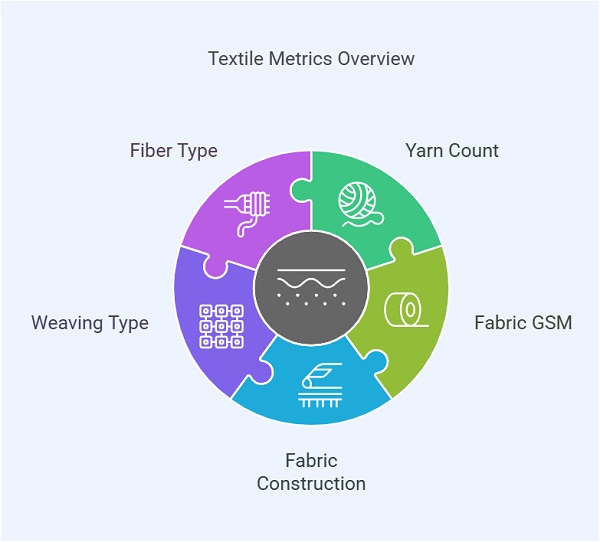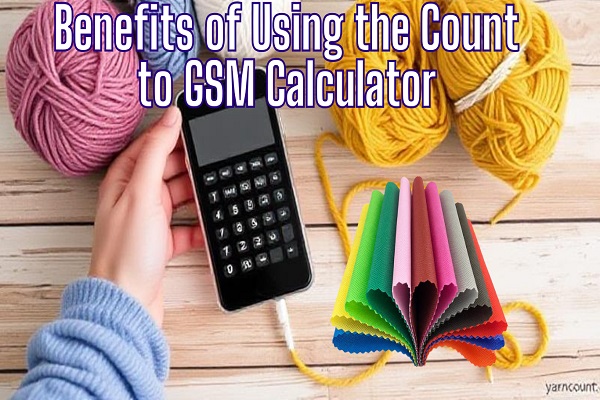Count to GSM Calculator
© Yarn Count Ltd
Disclaimer: All tools in the Yarn Count have been reviewed by the relevant spinning industry experts.
The formula for Count to GSM Calculation:
GSM = (39.37 × Count × Twist × Micronaire) ÷ 590.5
Where:
- GSM = Grams per Square Meter (Fabric Weight)
- Count = Yarn Count (Ne, Nm, Tex, or Denier)
- Twist = Number of twists per inch (TPI) in the yarn
- Micronaire = Fiber Fineness (typically used for cotton)
Table of Contents
Understanding Yarn Count and Fabric GSM
In textile manufacturing, converting yarn count to fabric GSM (grams per square meter) is essential for achieving the desired fabric weight and quality. The relationship between yarn count and GSM impacts fabric properties such as texture, durability, and cost. Our “Count to GSM Calculator” simplifies this process, enabling textile engineers to calculate fabric GSM quickly and accurately.

What is Yarn Count?
Yarn count is a numerical system that indicates the thickness or fineness of a yarn. It is defined as the relationship between the weight and length of the yarn. Different yarn count systems exist, with the most commonly used ones including:
- English Count (Ne): Used for cotton yarns, calculated as the number of 840-yard hanks in one pound.
- Metric Count (Nm): Commonly used in Europe, defined as the number of 1,000-meter lengths per kilogram.
- Tex and Denier: Direct systems where a higher number indicates a thicker yarn.
What is Fabric GSM?
Fabric GSM measures the weight of fabric in grams per square meter. It determines fabric thickness and influences applications, comfort, and durability. A higher GSM indicates a heavier and denser fabric, while a lower GSM corresponds to a lighter and more breathable fabric.
Relationship Between Yarn Count and GSM
Yarn count directly affects fabric GSM. Finer yarns (higher count) produce lightweight fabrics, while coarser yarns (lower count) result in heavier fabrics. Several factors influence GSM beyond yarn count, including:
- Fabric construction: Ends per inch (EPI) and picks per inch (PPI) impact GSM significantly.
- Weaving type: Plain weave, twill, and satin weave affect fabric density.
- Fiber type: Natural fibers like cotton and wool have different densities compared to synthetic fibers.
Understanding this relationship allows textile manufacturers to control fabric weight effectively.
Count to GSM Formula
To calculate GSM from yarn count, the following formula is commonly used:
GSM=(TPI+PPI) ÷ 2)×(Yarn Weight÷Fabric Area)
Where:
- TPI (Threads Per Inch): Number of warp threads per inch.
- PPI (Picks Per Inch): Number of weft threads per inch.
- Yarn Weight: Weight of a single yarn length.
This formula helps in estimating fabric GSM based on known yarn count and fabric construction details.
How to Use the Count to GSM Calculator
Our Count to GSM Calculator simplifies GSM calculations with an easy-to-use interface. Follow these steps:
- Select the Yarn Count System: Choose between Ne, Nm, tex, or denier.
- Enter the Yarn Count: Input the known count value.
- Specify Fabric Construction Details: Include EPI, PPI, and fabric type.
- Click Calculate: The tool will instantly generate the GSM value.
The calculator removes manual errors and ensures accurate predictions, saving time and improving efficiency in textile production.
Benefits of Using the Count to GSM Calculator

1. Accuracy
Manual calculations often result in errors, leading to inconsistencies in fabric quality. Our calculator ensures precise GSM estimations, improving product consistency.
2. Efficiency
Textile engineers and manufacturers can quickly determine GSM, speeding up decision-making in production planning.
3. Cost Management
Accurate GSM calculations help in estimating material usage and cost, optimizing production expenses.
4. Versatility
The calculator works for different yarn types, weaving methods, and fabric structures, making it suitable for various textile applications.
Practical Applications in Textile Industry
1. Fabric Quality Control
Manufacturers use GSM calculations to maintain consistent fabric quality. Ensuring uniform weight prevents defects and enhances fabric performance.
2. Product Development
Designers rely on GSM calculations to create fabrics suited for different end uses, from lightweight garments to heavy-duty textiles.
3. Textile Cost Estimation
Determining GSM helps estimate raw material consumption, reducing waste and controlling costs.
4. Garment and Home Textile Manufacturing
Clothing brands and home textile producers use GSM to ensure products meet weight and durability standards.
Common GSM Ranges for Different Fabrics
| Fabric Type | Common GSM Range |
| Lightweight Cotton | 100-150 GSM |
| Denim Fabric | 250-400 GSM |
| T-shirt Fabric | 120-180 GSM |
| Bedsheets | 180-250 GSM |
| Upholstery Fabric | 300-500 GSM |
These values provide a general guideline for selecting the right GSM for specific fabric applications.
Conclusion
The “Count to GSM Calculator” is an essential tool for textile professionals, enabling quick and accurate conversions between yarn count and fabric GSM. By integrating this tool into textile production workflows, manufacturers can ensure fabric consistency, optimize costs, and enhance efficiency. Whether for quality control, product development, or cost estimation, this calculator simplifies GSM calculations, supporting better decision-making in the textile industry.